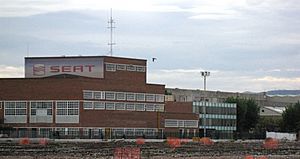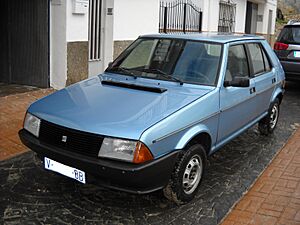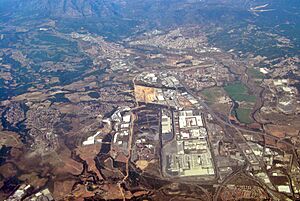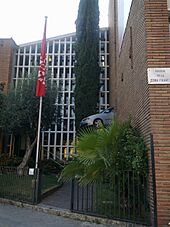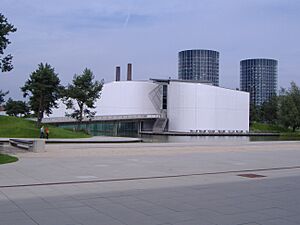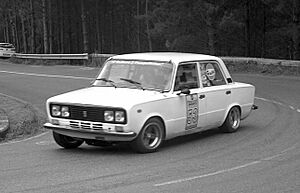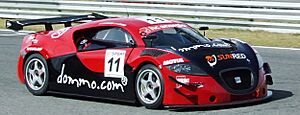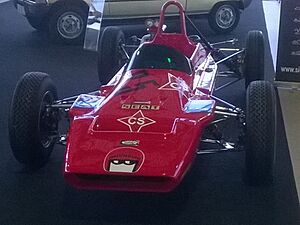SEAT facts for kids
 |
|
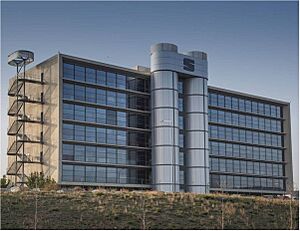
Headquarters in Martorell, Spain
|
|
|
Native name
|
Sociedad Española de Automóviles de Turismo (S.E.A.T.)
|
|---|---|
| Subsidiary | |
| Industry | Automotive |
| Founded | 9 May 1950 |
| Founder | Instituto Nacional de Industria |
| Headquarters | Martorell, Catalonia, Spain |
|
Area served
|
Europe, Middle East, Africa, Latin America (except Brazil and Argentina) and Singapore |
|
Key people
|
|
| Products | Cars, electric vehicles, automotive parts |
| Brands | SEAT Cupra |
|
Production output
|
|
| Services | Design, manufacture and distribution of SEAT cars and components |
| Revenue | |
|
Number of employees
|
14,751 (2020) |
| Parent | Volkswagen Group |
| Divisions | Cupra Racing |
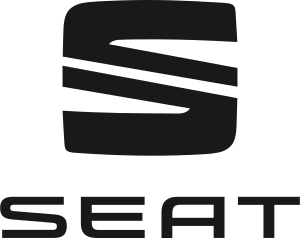 |
|
| Owner | Volkswagen Group |
|---|---|
| Introduced | 1953 |
| Related brands | Cupra |
SEAT S.A. is a Spanish car company that makes cars under the SEAT and Cupra names. It was started on May 9, 1950. The Spanish government and some banks worked with Fiat to create it.
For 36 years, SEAT was an independent car maker. Then, in 1986, the Spanish government sold SEAT to the Volkswagen Group. It is still a part of the Volkswagen Group today.
SEAT S.A.'s main office is in Martorell, near Barcelona, Spain. In 2020, the company made over 468,000 cars. More than 427,000 of these cars were sent to over 75 countries around the world.
Contents
History of SEAT
How SEAT Started
Spain is one of the biggest car makers in the world. Its car market is also one of the largest in Europe. But this wasn't always true. In the early 1900s, Spain's economy was not as strong as other European countries. It had a small car market.
Most cars made in Spain were luxury cars, like those from Hispano-Suiza. Regular cars were mostly imported or put together from imported parts by foreign companies. This meant Spain didn't get the technology or big investments needed to make many cars. The situation got much worse after the Spanish Civil War (1936-1939). People had less money, and foreign car companies stopped or struggled.
Because foreign companies weren't interested in Spain's weak car market, local groups saw a chance. SEAT's story began on June 22, 1940. A Spanish bank, Banco Urquijo, and other companies started 'Sociedad Ibérica de Automóviles de Turismo' (S.I.A.T.). They wanted to build Spain's own car company that could make many cars.
At first, they wanted S.I.A.T. to be a private company. But in 1941, the government-owned company Instituto Nacional de Industria (INI) stepped in. The goal was for the new national car brand to design and build cars in Spain, not just put together foreign parts. Spain didn't have much experience in making cars on a large scale. So, they looked for a foreign partner to help with technology and car designs. This partner would get money, shares, and other payments.
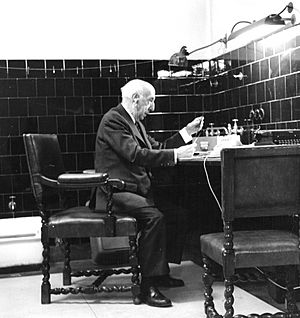
World War II and Spain's civil war damage caused delays. But the project was very important for the country, so it continued. SEAT, with its current name 'Sociedad Española de Automóviles de Turismo, S.A.' (S.E.A.T.), was officially started on May 9, 1950. It had a starting capital of 600 million Spanish pesetas (about 3.6 million euros today). This was a time when Spain needed to rebuild its economy after the war.
Almost two years before, on October 26, 1948, the Spanish government and six Spanish banks had made a deal with the Italian car maker Fiat. They wanted Fiat to be their foreign partner for Spain's main car company. Fiat won over Volkswagen for several reasons. Fiat was already well-known in Spain. It had also worked with a French company, Simca, showing it could handle big international projects. Fiat's experience in Italy, where many people had low incomes and small car markets, was similar to Spain's. Fiat also controlled the market for smaller cars in Italy, which would be the main market in Spain.
In 1947, the Banco Urquijo group restarted the S.I.A.T. project. The next year, they signed a three-part contract. INI would own 51% of the company, giving it control and making sure the company worked for the "national interest." Fiat was given a 7% share for its technical help. SEAT was meant to help Spain's economy recover and industrialize a country that was mostly farms.
At first, they thought about building the factory in cities like Valladolid or Burgos. But they chose the duty-free zone near the Port of Barcelona (Barcelona Zona Franca). This location offered better access to shipping and connections to Europe by train and road. Barcelona also had a long history of industry and skilled workers. Many early Spanish car makers and foreign car companies had factories there.
Because SEAT was so important for the country's economy, it received special benefits. It got tax breaks and technical help from Fiat. SEAT's first president was José Ortiz-Echagüe Puertas. He was an engineer, pilot, and photographer who had led a Spanish aircraft company. In 1976, he was made honorary president for life.
Working with Fiat
Building SEAT's Zona Franca factory started in 1950. It opened three years later, on June 5, 1953. Before that, since 1951, SEAT began to build up a whole network of suppliers. The very first car made by SEAT was a SEAT 1400 model. It rolled off the production line on November 13, 1953.
In the next few months, the factory made more cars and hired more people. They also started using more parts made in Spain. This helped reduce imports and grow Spain's own supplier industry. It also helped SEAT fulfill its role as the national car maker, helping Spain's economy after World War II. By 1954, 93% of the parts used were made in Spain. The factory officially opened on May 5, 1955.
However, the first SEAT car was a luxury model, so it was very expensive. Most Spanish people couldn't afford it. SEAT needed a cheaper car to compete with simpler, low-cost cars like the Biscúter. These cars were better for people with less money who needed a way to get around.
SEAT didn't have the skills to design its own cars at first. So, it made cars based on designs from its Italian partner, Fiat Automobiles. Sometimes, they would change the Fiat models to fit their needs. The first SEAT-only car, the SEAT 1200 Sport, came out in 1975. But the first unique SEAT car, the SEAT 800, arrived earlier in September 1963. This car was a longer, four-door version of the SEAT 600, and Fiat didn't have an equivalent model.

In 1957, SEAT started the SEAT Training Centre at its Zona Franca plant. This center trained skilled workers for the car industry. In the same year, the famous SEAT 600 was launched. This car was very important because it helped many Spanish families get their first car. It became a symbol of the "Spanish miracle" – a time of fast economic growth in Spain.
As SEAT made more and more cars each year, prices went down. This led to more sales and profits for the company. On June 29, 1964, SEAT opened its new main office in Madrid. This office handled all of the company's general business until 1972.
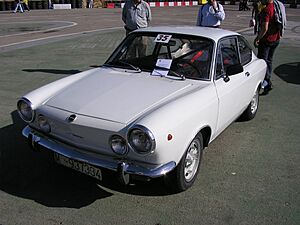
By 1967, SEAT was the biggest car maker in Spain. It was ahead of its rivals like FASA-Renault and Citroën-Hispania. SEAT made all its cars locally. In that year, Fiat and the Spanish government agreed to let SEAT export its cars. Before, there were limits on this. In return, Fiat increased its ownership in SEAT from 7% to 36%. The government's share went down from 51% to 32%. The Spanish banks owned the rest. Even though Fiat didn't own the majority, it had a lot of control. Fiat also promised to help SEAT grow and develop new models. On December 6, 1967, SEAT also started its own company, 'Financiera SEAT, S.A.' (Fiseat), to help customers finance their car purchases.
To do its own research, SEAT agreed with Fiat on November 16, 1970, to build separate facilities for new technologies. In 1972, SEAT set up temporary offices for its future technical center in Martorell. Construction began in 1973, and the first part of the center was finished in 1975.
During this time, SEAT continued to lead the Spanish car market. In 1971, it made 282,698 cars, which was over 58% of all cars made in Spain. This happened even with strikes and a flood at the Barcelona factory. Spain still had a lot of room for car sales to grow, as only 81 cars were owned per 1000 people. SEAT knew it would face more competition from other car makers wanting to build factories in Spain.
In 1973, SEAT and Citroën-Hispania worked together to start a factory in Vigo. This factory, called Industrias Mecánicas de Galicia, SA (Indugasa), made important parts for front-wheel drive cars. These parts were used by SEAT, Citroën-Hispania, and later Ford España. In 1986, this factory was sold to the company GKN.
In May 1975, the Spanish government asked SEAT to help save jobs at the factories of a bankrupt company called Authi. SEAT talked with Authi's parent company, British Leyland Motor Corporation (BLMC). SEAT agreed to buy Authi and its factories for 1,250 million pesetas in July 1975. This meant SEAT had to give up its plans to build a new factory in Saragossa. The Authi supplier factory in Manresa was sold, but the Landaben plant in Pamplona stayed with SEAT. It started making only SEAT cars in February 1976.
The 1970s were a time of growing wealth in Spain. In August 1976, SEAT announced it would start making the Lancia Beta. Three years later, SEAT began making Beta coupe and HPE lift-back versions at its Pamplona plant. These Spanish cars had simpler suspension and smaller engines than the Italian ones. This helped them qualify for a lower car tax.
In 1977, SEAT started its leasing company, Liseat. In 1979, the Gearbox del Prat factory was built near Barcelona. It specialized in making gearboxes and other parts.
Problems with Fiat
In the early 1980s, SEAT needed a lot of money to invest. Fiat, its main partner, was not willing to provide it. This was partly because of the oil crisis in the 1970s. Also, Fiat was unsure about its future in Spain after the government stopped protecting the market from companies like GM. So, in 1982, after almost 30 years, SEAT and Fiat ended their partnership. This was a surprising decision, especially since Spain was getting ready to join the European Economic Community.
The end of the Fiat partnership led to a new SEAT logo in 1982. The first car made by SEAT without Fiat's help was the SEAT Ronda, released in the same year. It was designed by Rayton Fissore and SEAT's technical center. Fiat sued SEAT, saying the Ronda was too similar to its own car, the Ritmo. To defend SEAT, its president, Juan Miguel Antoñanzas, showed a Ronda to the press. He had all the parts that were different from the Fiat Ritmo painted bright yellow. The case went to the Arbitration Chamber of Paris, which decided in 1983 that the cars were different enough. This ended the dispute in SEAT's favor. Some people thought Fiat was upset because the Ronda's new look was too much like Fiat's own planned changes for the Ritmo, which they then had to cancel.
Becoming Part of Volkswagen Group

In 1982, Dr. Carl Horst Hahn, the head of the Volkswagen Group, saw a chance to work with SEAT after Fiat left. He wanted to expand Volkswagen's business outside Germany and make it a global company. Other big car makers like Ford and General Motors had already set up factories in Spain. However, the Spanish government was also talking to other companies like Toyota, Nissan, and Mitsubishi to find a strong partner for SEAT.
Hahn's interest quickly led to a deal. On September 30, 1982, SEAT and Volkswagen agreed to work together. SEAT would make the Volkswagen Passat-Santana and Polo-Derby models in its Zona Franca and Landaben factories in Spain. Because of this, SEAT stopped making the SEAT Panda at the Landaben factory on April 29, 1983, to prepare for the VW Polo. On June 16, 1983, SEAT's president, Juan Miguel Antoñanzas, and Carl Hahn signed a partnership agreement. SEAT also got the right to sell Volkswagens in Spain.
In 1984, SEAT launched its new Ibiza. This car was designed by Giugiaro and used engines from Porsche. It also had parts from the Fiat Ritmo/Strada. The Ibiza was also the base for the Málaga, a four-door family car. SEAT started selling cars in other countries, like the United Kingdom, in the autumn of 1985.
On June 17, 1986, the Volkswagen Group bought 51% of SEAT. By December 23 of the same year, their share increased to 75%. The Volkswagen Group became the main owner of SEAT. On December 18, 1990, Volkswagen bought the remaining 25% of the company. This made SEAT the first non-German company fully owned by the Volkswagen Group.
SEAT became profitable two years after Volkswagen bought most of its shares. It also provided a way to make other VW models at a lower cost. In 1989, SEAT made up 15.2% of all cars produced by the VW group. It also helped Volkswagen enter the Spanish market, which was not fully explored at the time, with SEAT, VW, and Audi cars.
SEAT started moving its main facilities to the Martorell plant area. This process began in 1975 with the opening of the SEAT technical center. But it was in 1989 that they decided to build a new main assembly factory next to the technical center in Martorell. This new factory would replace the old one in Zona Franca. In the same year, SEAT also started moving its Madrid offices to Barcelona. This was finished in 1991, with SEAT's main office now in Catalonia.

Bringing together management, design, research, and production facilities around the Martorell plant helped make new car development better. On February 22, 1993, King Juan Carlos of Spain and the new head of the Volkswagen Group, Dr. Ferdinand Piëch, opened the Martorell plant. It was one of the most modern and efficient car factories in Europe. It used a "just-in-time" system, where parts arrived just when they were needed, from suppliers only 2.5 km away. The first cars made at Martorell were the SEAT Ibiza Mk2 and its sedan version, the SEAT Córdoba Mk1. The new Ibiza was very successful and helped SEAT sell many more cars, especially in other countries.
In October 1993, there were plans to close the old Zona Franca assembly plant once car production moved to Martorell. But the Spanish government and Volkswagen Group agreed to keep Zona Franca open. It would slowly become a factory that made parts like metal castings and pressed parts. Meanwhile, on December 23, 1993, a new company called 'Fábrica Navarra de Automóviles, S.A.' was created to manage the Landaben factory. Its shares were transferred to Volkswagen in June 1994. However, SEAT got ownership of it back four years later in 1998.
In 1994, the design center in Sitges (a coastal town south of Barcelona) and the suppliers' park in Zona Franca also opened. In the winter of that year, SEAT's financing and leasing companies, Fiseat and Liseat, were sold to Volkswagen Financial Services AG. In 1994, SEAT and Suzuki worked together to make a prototype of a small city car called Rosé. It was meant to replace the Marbella, but it was never produced.
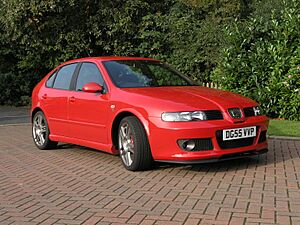
The first time a SEAT car was made outside Spain was in 1996. This was the SEAT Alhambra Mk1, made at the Palmela AutoEuropa plant in Portugal. Also, in January 1997, a Belgian person, Pierre-Alain de Smedt, became SEAT's chairman, the first non-Spanish person to hold that role. The SEAT Arosa, a small three-door car, was launched in 1997. It replaced the Marbella, which was SEAT's version of the Fiat Panda and had been made since the early 1980s.
On April 7, 1998, the Zona Franca plant stopped making the Marbella model. This was a big moment for SEAT, as it marked the end of car production at its oldest factory, which opened in 1953. Since then, the Zona Franca plant has made parts for cars to be put together elsewhere. It also marked the end of SEAT's last car based on a Fiat design.
In March 1999, at the Geneva Motor Show, SEAT showed a new, modern logo. It was more rounded and used silver on a red background instead of blue. Silver stood for logic, and red for emotion. This new logo appeared on the second-generation Toledo and then on the Leon hatchback, which was based on the Toledo.
The slogan "auto emoción" was introduced in September 2000. It showed the brand's new, young, and sporty image. SEAT Sport started developing SEAT's high-performance cars, in addition to its racing activities.
On July 1, 2000, Dr. Bernd Peter Pischetsrieder, who used to be the CEO of BMW, became the head of SEAT. In the spring of 2002, Pischetsrieder was asked to lead the entire Volkswagen Group. So, on March 7, 2002, Andreas Schleef took over as head of SEAT.
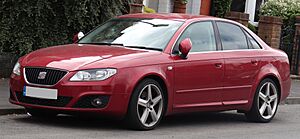
From 2002 to 2007, SEAT was part of the Audi Brand Group. This was a part of the Volkswagen Group that included Audi, SEAT, and Lamborghini. This group focused on sportier cars, and Audi was in charge of SEAT's car products and performance.
In 2006, the new SEAT main office opened in Martorell. The Martorell SEAT Design Centre took over from the Volkswagen Group Design Centre Europe in Sitges. The Sitges facility, which was jointly owned by SEAT, Volkswagen, and Audi, was transferred to the City of Sitges on February 23, 2006. The Martorell Design Centre officially opened on December 30, 2007.
On January 12, 2007, the SEAT Service Centre building opened near the Martorell factory. This department handles technical support, after-sales service, and marketing. It also manages the brand's relationship with customers and its global network. In January 2007, the SEAT Prototypes Centre of Development started operating. This facility, opened on July 16, 2007, brings together all activities related to making new car prototypes and pre-production models. This helps shorten the time it takes to develop new cars and saves costs by using modern technologies like virtual simulation.
SEAT participated in a program that revealed anti-competitive practices among car makers and sellers in Spain. These companies shared sales and repair information, controlling 91% of the market between 2006 and 2013. Because SEAT cooperated, it and its group companies avoided penalties in 2015.
Leadership at SEAT
- José Ortiz Echagüe (1950–1967)
- Juan Sánchez Cortés (1967–1977)
- Juan Miguel Antoñanzas Pérez-Egea (1984–1993)
- Peter Walzer (1993)
- Juan Llorens Carrió (1993–1996)
- Pierre-Alain de Smedt (1997–1999)
- Bruno Adelt (1999–2000)
- Bernd Pischetsrieder (2000–2002)
- Andreas Schleef (2002–2006)
- Eric Schmitt (2006–2009)
- James Muir (2009–2013)
- Jürgen Stackmann (2013–2015)
- Luca de Meo (2015–2020)
- Carsten Isensee (2020)
- Wayne Griffths (2020–present)
SEAT's Factories
Martorell Facilities
SEAT's main office and factories are in Martorell, an industrial town about 30 km northwest of Barcelona. This factory can make around 500,000 cars each year. King Juan Carlos of Spain opened this plant on February 22, 1993. It became SEAT's main factory, working alongside its assembly plant in Barcelona's free port zone (Zona Franca). A train line connects SEAT's Martorell and Zona Franca sites. This helps move cars and parts between the two locations.
The Martorell complex has many important facilities. These include Cupra Racing (formerly SEAT Sport), SEAT's Technical Center, Research and Development (R&D) Center, Design Center, Prototypes Centre of Development, and the SEAT Service Center. The Service Center includes After-Sales Service and Customer Services. It also has the Catalunya Motor dealership and the Genuine Parts Centre for SEAT, Volkswagen, Audi, and Škoda brands. The Martorell factory can also help the former SEAT plant in Pamplona, which is now owned by Volkswagen-Audi-Espana, S.A.
Cars made at Martorell include the Arona, Formentor, Ibiza, Leon, Leon Sportstourer, and Audi A1.
- SEAT Technical Centre: Located in Martorell, this center focuses on research and development (R&D). Over 1,294 people work there. SEAT fully develops new cars at this center, which covers an area of 200,000 square meters. They use virtual reality to design new SEAT cars.
- SEAT Design Center: This center officially opened in 2007 and is part of the SEAT Technical Center. It brings together the entire car design process. As of 2020, 100 people work there.
- Prototype Development Centre (PDC): Opened in 2007, the PDC is one of SEAT's key projects. It combines all activities related to the early stages of designing and developing new car models. It brings together the knowledge, people, and resources from different prototype departments. This helps shorten the time it takes to develop prototypes and pre-production cars. It also saves costs by using modern technologies like virtual simulation.
- Spare Parts Centre: This 75,000 square meter area distributes parts and components. It sends them to SEAT, Volkswagen, Audi, and Škoda dealers in Spain. It also sends parts to SEAT dealers in Portugal and SEAT importers worldwide.
- SEAT Service: This facility includes the After-Sales Service, SEAT Technical Training Centre, and the Catalunya Motor dealership. It covers 8,000 square meters. As of 2020, 170 employees work here.
- Cupra Racing (formerly SEAT Sport): This 16,000 square meter facility is near the Martorell factory and the SEAT Technical Centre. This is where SEAT adds sporty features to its cars and prepares different racing models, like the Cupra León Competition or the Cupra e-Racer.
Zona Franca Facilities
SEAT's factory in Barcelona's Zona Franca started in 1953. It was where the first SEAT cars, like the SEAT 1400 and 600, were made. In 1993, car production began to move to the new Martorell plant. Since then, the Barcelona factory has been making parts like doors, roofs, fenders, and car frames.
This factory makes 80% of the parts for the MQB A0 platform. This is a special platform used for compact cars like the Ibiza and Arona. It also makes most of the stamped metal parts for all other SEAT models. The development and assembly facilities here are very modern within the Volkswagen Group. They can make cars not only for SEAT but also for other Volkswagen Group brands like Volkswagen and Audi. For example, several Audi models (like the Audi A1, Audi A3 Sportback, and Audi Q5) were developed and designed here.
This plant is a leader in the industry. It uses advanced features like virtual simulation for its presses, 3D printing in its maintenance workshop, and robots that automatically change sealing tips in the body shop. It also uses automated guided vehicles to move materials around.
The Barcelona Zona Franca site includes the SEAT Training Centre and the Zona Franca Press Shop factory, which makes stamped body parts. It also has the Barcelona Gearbox del Prat plant, which makes gearboxes for SEAT and other Volkswagen Group brands (Volkswagen, Audi, and Škoda). This gearbox plant won the Volkswagen Excellence Award in 2009 for its high-quality production.
Other Manufacturing Plants
SEAT also owned the Landaben plant in Pamplona from 1975. But in December 1993, it was transferred to the Volkswagen Group. Today, this plant makes Volkswagen cars in Spain. However, SEAT's Martorell site still helps the Pamplona plant when needed. For example, it helped after a serious fire in the paint shop there in April 2007.
Other Volkswagen Group factories that make SEAT models include the Bratislava site in Slovakia and the Volkswagen Zwickau-Mosel Plant in Zwickau, Germany. The Cupra Born electric car is made in Zwickau alongside the Volkswagen ID.3 electric vehicle. The AutoEuropa factory in Palmela, Portugal, and Wolfsburg in Germany also make SEAT cars. Since 2016, SEAT has a museum in the Zona Franca's 'Nave A122' site. It displays all the production and prototype models SEAT has ever shown, along with special cars important to the brand's history.
One of SEAT's companies, SEAT Deutschland GmbH, is in Mörfelden-Walldorf, Germany. Besides selling cars, it runs SEAT's electronic platform, the SEAT IT Services Network. In Wolfsburg, Germany, inside the Autostadt (Volkswagen Group's theme park), there is a large SEAT pavilion.
Other Company Facilities
- Casa SEAT: This is a special urban mobility lab that opened in June 2020. It is located in Passeig de Gràcia in Barcelona and is the main office for SEAT MÓ, which focuses on urban mobility solutions.
- SEAT:CODE (Center of Digital Excellence): This is SEAT's software development center. Since it started in 2019, it has led the company's digital changes. It creates digital solutions for SEAT, Cupra, and SEAT MÓ. In July 2020, this center opened its main office in Barcelona.
- SEAT's Dealers: Besides selling new SEAT and Cupra cars, some dealers also offer used cars or "KM0" cars (cars that have traveled very few kilometers) under the DasWeltAuto company, which belongs to the Volkswagen Group. Many dealers also provide car maintenance, parts, and repairs. Outside Spain, SEAT has distributors in over 70 countries.
- SEAT Componentes: This factory in El Prat de Llobregat (Barcelona) makes gearboxes for SEAT, Volkswagen, Audi, and Škoda. It was founded in 1979 and covers over 150,000 square meters. It can make up to 3,500 gearboxes every day, from casting the metal to assembling and checking quality. In 2020, this factory had over 1,000 employees. It produced two different gearbox models, the MQ200 and the new MQ281. Together, they can make up to 800,000 gearboxes per year.
Where SEAT Sells Cars
From 1953 to 1965, SEAT only made cars for the Spanish market. In 1965, the company sent about 150 SEAT 600 models (a version of the Fiat 600) to Colombia by air. This was a symbolic first export. Two years later, in 1967, SEAT made a new deal with Fiat. This allowed SEAT to set up an international network to sell its cars. It started exporting to over 12 countries in 1969. However, until the early 1980s, most SEAT cars sold outside Spain had Fiat badges.
After SEAT won its legal case against Fiat in 1983, a quarter of its production went to Egypt and Latin America. In Europe, SEAT cars were sold in West Germany, Belgium, France, Italy, Austria, and Greece. Plans were made to add the UK, Ireland, and Scandinavian markets in 1984. This was despite the company only being able to export the Ronda and later the Fura. Exports grew quickly in the 1970s under the leadership of Juan Sánchez Cortés and export director José María García-Courel.
Today, SEAT sells its cars in over 70 countries worldwide, following the Volkswagen Group's plans. Almost three-quarters of its yearly production is exported. Europe is still its main market. Outside Europe, Mexico is SEAT's most successful market, with dealers in 27 Mexican states.
In Europe, the brand is sold in almost 40 countries. SEAT also sells cars in 11 countries in Asia, mostly in the Middle East. It is present in 16 countries in the Americas, including North, Central, and South America, and the Caribbean. Finally, it sells cars in Africa, mainly North Africa. Some SEAT cars have been sold outside Europe under the Volkswagen name. For example, the SEAT Ibiza hatchback was known as the Volkswagen Polo Playa in South Africa. The SEAT Inca van was called the Volkswagen Caddy, and the SEAT Córdoba was known as the Volkswagen Polo Classic.
In 2012, SEAT planned to expand into the Chinese market. First, it would sell Spanish-made models, and later, it would assemble SEAT models in China.
SEAT's plans to expand into more markets outside Europe are still ongoing. The company considered launching in the United States in the past, but this never happened. There have also been rumors that a SEAT model might be sold as a Volkswagen in Canada and the United States to add to Volkswagen's car lineup there. However, these rumors have not been true.
In the past, SEAT was also present for a short time in Australia and New Zealand (from 1995 to 1999) and South Africa (from June 2006 to the end of 2008). But the brand was pulled from these markets because Volkswagen decided it was not practical to keep importing a niche brand there. SEAT sold cars in Russia from 2007 to 2015. SEAT returned to the New Zealand market in 2017. SEAT re-entered the Australian market in 2022, selling cars under its performance brand Cupra. SEAT plans to re-launch in the United States and Canada from mid-2024 to early-2027, selling vehicles under its performance brand Cupra.
Cupra Brand
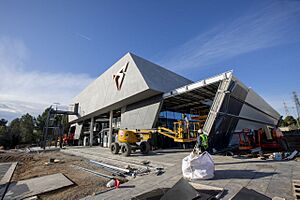
In 2018, Cupra, which used to be a high-performance trim level for SEAT cars, became its own separate brand alongside SEAT. At the same time, SEAT Sport became Cupra Racing. Cupra describes itself as a unique and exciting brand. It focuses on cool style and modern performance, aiming to inspire the world from Barcelona with its advanced cars and experiences. Cupra has its main office in Martorell, Spain, and sells its cars through special dealerships around the world.
Motorsport Activities
SEAT started getting involved in motorsports in the 1970s. It helped with national formula races in Spain and later with rallies. In 1971, a Special Vehicles department was created to help the brand compete in rally championships. This led to 11 titles between 1979 and 1983. In 1985, SEAT Sport was founded as a separate motorsport division. After the Volkswagen Group took over in 1986, SEAT became even more involved in motorsports. This was part of VW's plan to make SEAT a sporty brand that would appeal to younger drivers.
These efforts led to SEAT winning major titles in FIA championships. The SEAT Ibiza Kit-Car won the FIA 2-Litre World Rally Cup three times (1996, 1997, 1998). The SEAT León won the FIA World Touring Car Championship twice (2008, 2009).
Rallying
SEAT's first serious attempt at the World Rally Championship (WRC) was in the 1977 season. SEAT competed with its SEAT 1430/124D Especial 1800 race car. In its first rally, the Montecarlo Rally, the SEAT team finished third and fourth.
Later, SEAT focused on the small SEAT Ibiza. This was a 1.6-liter, front-wheel drive car based on the Volkswagen Polo. The Ibiza helped the company gain more experience in rallying. A 2-liter version of the Ibiza was made into a "kit car." It had wider tracks, larger wheels, and bigger brakes, as allowed by the Fédération Internationale de l'Automobile (FIA) kit-car rules. With these changes, the car won the 2-Litre World Rally Cup three times (1996, 1997, 1998). This showed that SEAT had enough experience and money to move to the top category, the World Rally Car class.

SEAT's three wins in the FIA 2L WRC and the popularity of rallying in Spain likely convinced the Volkswagen Group to let the SEAT Sport department aim for the top WRC category. However, in September 2000, Volkswagen's management changed its mind and made SEAT Sport leave the World Rally Championship.
SEAT officially announced its plan to build a WRC-spec car during the 1997 San Remo rally. In 1998, the first version of the SEAT Córdoba WRC car was shown at the Porto Motor Show. It then competed at the highest level of WRC racing. The Córdoba WRC was based on the family sedan but was a WRC class car. It had a four-cylinder turbocharged petrol engine, permanent four-wheel drive, and special differentials. The Córdoba WRC first raced at the 1998 Rally of Finland. A more developed race car, the SEAT Córdoba WRC E2, was shown at the Barcelona Motor Show in 1999. However, the Córdoba's short wheelbase and high-mounted engine (compared to its rivals) made it less competitive. Even after hiring former WRC champion Didier Auriol and releasing a new version, the SEAT Córdoba WRC E3, SEAT left international rallying at the end of 2000.
Touring Cars
In 2002, SEAT announced a special championship for its new SEAT León Cupra R, called the SEAT León Supercopa.
In 2004, SEAT, with Ray Mallock Ltd. (RML), joined the British Touring Car Championship. They raced two SEAT Toledo Cupra cars with drivers Jason Plato and Rob Huff. In 2005, Huff left, and James Pickford and Luke Hines joined as SEAT expanded to three cars. In 2006, the Toledo was replaced by the new León. Darren Turner and James Thompson also joined the team. 2007 was SEAT's best year in BTCC, with Plato almost winning the title.

Since 2005, SEAT has also competed in the World Touring Car Championship. Its best season was 2007. SEAT became the first team to race a TDI (diesel) car in the WTCC. This led to a very successful 2008 World Touring Car Championship season, with Yvan Muller winning the driver's championship. The French racing team Oreca works with the WTCC team. SEAT's UK team also used TDI cars in the 2008 BTCC.
In 2007, SEAT, with the León Mk2 TDI at the Motorsport Arena Oschersleben in Germany, became the first car maker to win a race in the World Touring Car Championship (WTCC) series with a diesel car. This happened just a month after they announced they would enter the FIA World Touring Car Championship with the León TDI. SEAT's success with the León TDI continued. They won both the drivers' and manufacturers' titles in the 2008 and 2009 World Touring Car Championships.
In September 2008, SEAT UK announced it would stop all motorsport activities in the UK at the end of the season. The SEAT Cupra Championship and the SEAT BTCC campaign ended on September 21.
At the start of the 2009 WTCC, SEAT cars finished 1st, 2nd, 3rd, and 4th in both races in Brazil. At the second WTCC event in Mexico, the SEAT team finished 1st, 4th, 6th, 7th, and 11th in the first race. In the second race, they finished 1st, 3rd, 7th, and 8th. Even though SEAT left the BTCC, they showed impressive results in the WTCC.
Grand Tourer Cars
In 2003, the SEAT Sport division showed the SEAT Cupra GT race car at the Barcelona Motor Show. It was first a concept car and then a final version. This car was made in limited numbers for customers and racing teams who wanted to compete.
The Cupra GT was chosen by racing teams, like the Sunred Engineering (SunRED) team. It first raced in 2004 in the Spanish GT Championship. It also competed in several Grand tourer races not only in Spain but also on tracks like Monza and Magny-Cours.
Formula Racing
In 1970, SEAT started the 'Fórmula Nacional' series in Spain, which later became known as Formula 1430. Young Spanish drivers raced single-seater cars in this series. These cars were supported by SEAT and used 1430 model engines and 6700 gearboxes. The first 'Fórmula Nacional' race took place at the Jarama circuit in Madrid.
SEAT Car Models
SEAT Models
| Ibiza | León | Arona | Ateca |
|---|---|---|---|
| Supermini | Small family car | B-segment Crossover | C-segment Crossover |
|
|
|
|
Cupra Models
| León | Ateca | Formentor | Born | Tavascan | Terramar |
|---|---|---|---|---|---|
| Small family car | C-segment Crossover | CUV Coupé | Small family car | C-segment Crossover | C-segment Crossover |
|
|
|
|
|
|
Car Names
SEAT often names its car models after places in Spain. For example, you'll find names like Arosa, Ibiza, Córdoba, León, and Toledo.
However, there are some exceptions. The SEAT Exeo, added in 2008, got its name from the Latin word exire, meaning "to go beyond."
SEAT's concept cars (cars made to show new ideas) also have interesting names. Many are named after Spanish dances, like tango, bolero, and salsa. Others are abbreviations related to existing models, like IBZ for Ibiza. Some names recall SEAT's racing history, such as Fórmula and Cupra GT.
In recent years, special versions of cars have been added. "SC" means SportCoupé for three-door cars. "ST" means SportTourer for estate or wagon versions. "Cupra" (for "Cup Racing") and "FR" (for "Fórmula Racing") are used for high-performance models. These names show that SEAT is a sporty brand involved in racing.
The famous "Bocanegra" name means "black mouth" in Spanish. It's used for the Ibiza model and comes from the SEAT 1200 Sport. That car was called the original SEAT Bocanegra because of its black front part.
Special Car Ranges
Ecomotive Range
Most SEAT models have an 'Ecomotive' version. These cars are designed to be more eco-friendly than the standard versions. They are lighter, use special tires that roll easily, and have improved aerodynamics. Their engines are tuned to be more efficient, and diesel models have a special filter to reduce pollution. The gearbox and gear ratios are also updated, with a gearshift indicator to tell you when to change gears for better fuel economy. They also have a 'Start/Stop system' that turns the engine off when you stop and an 'Energy Recuperation system' that saves energy when you slow down.
All these changes help reduce fuel use and emissions without making the car less fun to drive or practical. For example, the SEAT Ibiza Ecomotive 1.4 TDI has very low CO2 emissions (98 g/km). It's even faster from 0 to 100 km/h than the standard version, and it comes with five doors and air conditioning. The SEAT León Ecomotive also has very low CO2 emissions, at 99 g/km.
The Ecomotive range has won many awards. In 2008, the Ibiza Ecomotive was named the "environmentally beneficial vehicle" by Verkehrs-Club Deutschland. It also won in the small diesel class and was the overall winner in the 10th Eco Tour. In that year, the SEAT Ibiza Ecomotive also received the 'Ecobest 2008' award. The German newspaper Bild am Sonntag called it the 'most economic car of its class in the world'.
In 2009, the Ibiza Ecomotive was nominated for the 'Green Steering wheel' award in Switzerland. It also set two new world records for fuel saving on a single tank, confirmed by the IPMC (International Police Motor Corporation). First, Austrian driver Gerhard Plattner drove from Martorell (Spain) to Göttingen (Germany) using only 2.9 liters of fuel per 100 km. Second, he drove from Cieszyn (Poland) to Frankfurt (Germany), achieving a world record of 2.34 liters per 100 km (or 100 mpg U.S.), covering 1,910 km on one tank.
MultiFuel Range
The MultiFuel range uses "flexible-fuel" bio-ethanol technology in some SEAT models. These include the SEAT León MultiFuel, the SEAT Altea MultiFuel, and the SEAT Altea XL MultiFuel. They use a 1.6 MPI MultiFuel E85 engine. This engine produces the same horsepower (102 bhp) as the regular petrol version.
Sales Numbers
Since SEAT started in 1953, it has made over 16 million cars. The most popular car has been the SEAT Ibiza, with over 4 million units sold across its four generations.
In 2009, SEAT sold 336,683 cars. The company produced 307,502 vehicles under the SEAT brand that year. Most of these (301,287) were made at SEAT's Martorell plant, and 6,215 were made at other Volkswagen Group factories.
The table below shows the total number of SEAT and Cupra cars produced each year by SEAT/Cupra and other Volkswagen Group plants. This table does not include cars from other Volkswagen Group brands that were made in SEAT-owned factories.
| Model | 1986 | 1987 | 1988 | 1989 | 1990 | 1991 | 1992 | 1993 | 1994 | 1995 | 1996 | 1997 | 1998 | 1999 | 2000 | 2001 | 2002 | 2003 | 2004 | 2005 | 2006 | 2007 | 2008 | 2009 | 2010 | 2011 | 2012 |
2013 |
2014 |
2015 |
2016 | 2017 | 2018 | 2019 | 2020 | 2021 | 2022 | 2023 | 2024 |
|---|---|---|---|---|---|---|---|---|---|---|---|---|---|---|---|---|---|---|---|---|---|---|---|---|---|---|---|---|---|---|---|---|---|---|---|---|---|---|---|
| SEAT Marbella | 36,879 | 56,893 | 71,519 | 82,935 | 90,903 | 80,005 | 74,637 | 33,216 | 27,102 | 29,621 | 21,930 | 18,139 | 2,337 | — | — | — | — | — | — | — | — | — | — | — | — | — | — | — | — | — | — | — | — | — | — | — | — | ||
| SEAT Arosa | — | — | — | — | — | — | — | — | — | — | — | 42,741 | 38,338 | 46,410 | 28,403 | 22,980 | 19,627 | 13,814 | 9,368 | — | — | — | — | — | — | — | — | — | — | — | — | — | — | — | — | — | — | — | — |
| SEAT Mii | — | — | — | — | — | — | — | — | — | — | — | — | — | — | — | — | — | — | — | — | — | — | — | — | — | 990 | 26,409 | 25,489 | 25,845 | 24,516 | 18,720 | 13,825 | 14,369 | 11,479 | 7,593 | 8,648 | — | — | — |
| SEAT Ibiza | 121,526 | 160,907 | 192,024 | 208,210 | 202,157 | 173,236 | 112,334 | 142,987 | 140,974 | 158,284 | 153,000 | 168,492 | 180,775 | 194,245 | 199,279 | 188,427 | 197,311 | 220,497 | 183,754 | 168,645 | 183,848 | 172,206 | 192,470 | 173,715 | 189,083 | 191,183 | 160,887 | 145,041 | 153,633 | 160,451 | 149,988 | 160,377 | 120,287 | 130,243 | 74,564 | 83,710 | 60,385 | 74,355 | 108,058 |
| Cupra Raval | — | — | — | — | — | — | — | — | — | — | — | — | — | — | — | — | — | — | — | — | — | — | — | — | — | — | — | — | — | — | — | — | — | — | — | — | — | — | 2 |
| SEAT Arona | — | — | — | — | — | — | — | — | — | — | — | — | — | — | — | — | — | — | — | — | — | — | — | — | — | — | — | — | — | — | — | 17,527 | 110,926 | 134,611 | 78,823 | 98,656 | 85,717 | 76,594 | 88,478 |
| SEAT Terra | 18,444 | 18,238 | 24,925 | 22,007 | 35,430 | 22,198 | 25,034 | 10,626 | 6,517 | — | — | — | — | — | — | — | — | — | — | — | — | — | — | — | — | — | — | — | — | — | — | — | — | — | — | — | — | — | |
| SEAT Inca | — | — | — | — | — | — | — | — | — | 3,921 | 16,836 | 14,414 | 17,226 | 19,221 | 16,328 | 15,207 | 11,802 | 7,982 | — | — | — | — | — | — | — | — | — | — | — | — | — | — | — | — | — | — | — | — | — |
| SEAT Inca Kombi | — | — | — | — | — | — | — | — | — | 104 | 9,328 | 11,070 | 7,708 | 8,573 | 5,534 | 5,316 | 3,879 | 2,150 | — | — | — | — | — | — | — | — | — | — | — | — | — | — | — | — | — | — | — | — | — |
| SEAT Córdoba | — | — | — | — | — | — | — | 19,289 | 84,128 | 79,793 | 77,436 | 96,946 | 108,749 | 111,894 | 97,685 | 78,770 | 58,646 | 59,348 | 46,821 | 37,568 | 31,058 | 29,747 | 20,439 | 4,861 | — | — | — | — | — | — | — | — | — | — | — | — | — | — | — |
| SEAT León | — | — | — | — | — | — | — | — | — | — | — | — | — | 6,080 | 93,123 | 91,939 | 93,606 | 96,536 | 90,850 | 98,130 | 126,511 | 120,630 | 96,761 | 66,368 | 79,462 | 80,736 | 71,295 | 114,568 | 157,087 | 169,455 | 163,228 | 163,306 | 159,486 | 153,837 | 124,323 | 83,813 | 56,317 | 102,965 | 105,864 |
| Cupra Born | — | — | — | — | — | — | — | — | — | — | — | — | — | — | — | — | — | — | — | — | — | — | — | — | — | — | — | — | — | — | — | — | — | — | — | 4,801 | 36,153 | 45,748 | 42,922 |
| SEAT Altea | — | — | — | — | — | — | — | — | — | — | — | — | — | — | — | — | — | — | 67,125 | 65,174 | 58,288 | 71,377 | 54,770 | 32,791 | 43,351 | 42,329 | 27,478 | 21,284 | 19,142 | 13,001 | — | — | — | — | — | — | — | — | — |
| SEAT Málaga | 41,292 | 37,653 | 39,269 | 36,882 | 33,098 | 8,735 | — | — | — | — | — | — | — | — | — | — | — | — | — | — | — | — | — | — | — | — | — | — | — | — | — | — | — | — | — | ||||
| SEAT Toledo | — | — | — | — | 41 | 76,336 | 144,205 | 90,533 | 47,965 | 55,493 | 53,404 | 42,596 | 42,325 | 105,818 | 59,480 | 47,645 | 39,503 | 36,026 | 38,962 | 20,600 | 8,613 | 4,744 | 5,484 | 571 | — | — | 5,000 | 21,771 | 16,541 | 19,728 | 18,029 | 13,146 | 10,151 | 1,506 | — | — | — | — | — |
| SEAT Exeo | — | — | — | — | — | — | — | — | — | — | — | — | — | — | — | — | — | — | — | — | — | — | 369 | 22,981 | 23,108 | 19,559 | 10,854 | 4,681 | — | — | — | — | — | — | — | — | — | — | — |
| SEAT Alhambra | — | — | — | — | — | — | — | — | — | — | 10,513 | 16,503 | 21,300 | 27,440 | 23,924 | 26,524 | 26,308 | 23,693 | 21,580 | 14,902 | 14,352 | 14,242 | 10,282 | 6,215 | 10,023 | 18,139 | 19,393 | 19,990 | 22,612 | 27,925 | 31,214 | 33,638 | 19,588 | 23,015 | 14,672 | 4,169 | 5,341 | — | — |
| SEAT Ateca | — | — | — | — | — | — | — | — | — | — | — | — | — | — | — | — | — | — | — | — | — | — | — | — | — | — | — | — | — | — | 35,833 | 77,483 | 90,824 | 98,397 | 76,710 | 58,500 | 58,157 | 83,714 | 74,592 |
| SEAT Tarraco | — | — | — | — | — | — | — | — | — | — | — | — | — | — | — | — | — | — | — | — | — | — | — | — | — | — | — | — | — | — | — | — | 2,398 | 38,721 | 18,726 | 22,437 | 12,453 | 25,562 | 8,856 |
| Cupra Formentor | — | — | — | — | — | — | — | — | — | — | — | — | — | — | — | — | — | — | — | — | — | — | — | — | — | — | — | — | — | — | — | — | — | — | 11,041 | 58,863 | 105,568 | 124,670 | 110,611 |
| Cupra Terramar | — | — | — | — | — | — | — | — | — | — | — | — | — | — | — | — | — | — | — | — | — | — | — | — | — | — | — | — | — | — | — | — | — | — | — | — | — | — | 16,663 |
| Cupra Tavascan | — | — | — | — | — | — | — | — | — | — | — | — | — | — | — | — | — | — | — | — | — | — | — | — | — | — | — | — | — | — | — | — | — | — | — | — | — | — | 27,172 |
| Total | 218,141 | 273,691 | 327,737 | 350,034 | 361,629 | 360,510 | 356,210 | 296,651 | 306,686 | 327,216 | 342,447 | 410,901 | 418,758 | 519,681 | 523,756 | 476,808 | 450,682 | 460,046 | 458,460 | 405,019 | 422,670 | 412,946 | 380,575 | 307,502 | 345,027 | 352,936 | 321,316 | 352,824 | 394,860 | 415,076 | 417,012 | 479,302 | 528,029 | 591,809 | 406,452 | 423,597 | 420,091 | 533,608 | 583,218 |
Rebadged Cars
When the Volkswagen Group owned SEAT, many SEAT models were also sold under other brands. These could be other brands within the Volkswagen Group or even outside of it.
For example, the SEAT Ibiza Mk2 was also sold as the VW Polo Playa under the VW brand. The SEAT Córdoba Mk1 was called the VW Polo Classic, FAW-VW City-Golf, or VW Derby. The SEAT Arosa was sold as the VW Lupo, and the SEAT Inca as the VW Caddy.
Some SEAT models were also rebadged by companies outside the Volkswagen Group. Notable examples include the SEAT Ibiza Mk1, which was sold as the Nanjing Yuejin Eagle NJ6400-Unique NJ6400-Soyat NJ7150-Soyat Unique NJ1020. The SEAT Toledo Mk1 was rebadged as the Chery A11-Fulwin-Fengyun-Windcloud, Chery A15-A168-Amulet-Cowin-Qiyun-Flagcloud, and Vortex Corda.
On the other hand, some SEAT models were rebadged versions of cars from other Volkswagen Group brands. For instance, the SEAT Alhambra Mk1 and Mk2 came from the VW Sharan Mk1 and Mk2. The first generation was a joint project between the Volkswagen Group and Ford. The SEAT Exeo was a rebadged version of the Audi A4 B7.
Car Tuning Companies
Several companies have created modified or high-performance versions of SEAT cars. Some well-known examples include Abt Sportsline, Je Design, APR, MTM, Abarth, Emelba, and Podadera Design.
Company Information
SEAT Logo History
Company Leaders
As a part of the Volkswagen Group, SEAT's leaders are chosen with approval from the group's main board.
| From | To | Person(s) |
|---|---|---|
| 1950 | May 1967 | José Ortiz-Echagüe Puertas |
| May 1967 | February 1977 | Juan Sánchez Cortés |
| February 1977 | December 1983 | Juan Miguel Antoñanzas Pérez-Egea |
| January 1984 | September 1993 | Juan Antonio Díaz Álvarez |
| October 1993 | October 1993 | Peter Walzer |
| November 1993 | December 1996 | Juan Llorens Carrió |
| January 1997 | June 1999 | Pierre-Alain de Smedt |
| 18 June 1999 | 30 June 2000 | Bruno Adelt |
| 1 July 2000 | 6 March 2002 | Bernd Pischetsrieder |
| 7 March 2002 | 30 September 2006 | Andreas Schleef |
| 1 October 2006 | 31 August 2009 | Erich Schmitt |
| 1 September 2009 | 30 April 2013 | James Muir |
| 1 May 2013 | 30 September 2015 | Juergen Stackmann |
| 1 November 2015 | 6 January 2020 | Luca de Meo |
| 7 January 2020 | 30 September 2020 | Carsten Isensee |
| 1 October 2020 | 31 March 2025 | Wayne Griffiths |
| 1 April 2025 | present | Markus Haupt |
Financial Results
| Year | After-tax result (in millions of euros) |
|---|---|
| 1996 | + 32,088 |
| 1997 | + 66,418 |
| 1998 | + 147,020 |
| 1999 | + 85,403 |
| 2000 | + 87,348 |
| 2001 | + 233,121 |
| 2002 | + 202,965 |
| 2003 | + 134,494 |
| 2004 | + 144,957 |
| 2005 | - 62, 513 |
| 2006 | - 49,088 |
| 2007 | + 169,703 |
| 2008 | + 44,400 |
| 2009 | - 186,500 |
| 2010 | - 103,900 |
| 2011 | - 61,500 |
| 2012 | - 29,600 |
| 2013 | - 148,700 |
| 2014 | - 65,700 |
| 2015 | + 6,000 |
| 2016 | + 903,200 |
| 2017 | + 281,200 |
| 2018 | + 294,200 |
| 2019 | + 345,600 |
| 2020 | + 194,200 |
Slogans
SEAT does not currently use a slogan. Here are some slogans SEAT used in the past:
- SEAT, Grupo Volkswagen (19??–????; this wasn't really a slogan, but showed it was part of Volkswagen Group)
- SEAT, auto emoción (2000–2011)
- SEAT, Enjoyneering (2011–2014)
- SEAT, Technology to Enjoy (2014–2017)
Environmental Efforts
Electric and Hybrid Car Development
Since the early 1990s, SEAT has worked on and shown several electric or hybrid car prototypes. These include the SEAT Toledo Mk1 electric model (1992), the SEAT Ibiza Mk2 electric car (1993), and the SEAT Inca electric van (1995). More recently, they developed hybrid cars like the SEAT León Mk2 Twin drive (2009), the SEAT IBE concept (2010), and the SEAT IBX concept SUV (2011).
'SEAT al Sol' Project
The 'SEAT al Sol' project uses photovoltaic panels to create electricity at SEAT's factory in Martorell. This project started in early 2010 with GA-Solar. It covers 320,000 square meters of the factory with over 10 MW of solar panels. This system is expected to produce more than 13 million kWh of electricity each year. This helps reduce greenhouse gas emissions by over 6,200 tonnes of CO2 annually.
'Cenit Verde' Project
The Cenit VERDE project is a research program supported by the Spanish Ministry of Science and Innovation. SEAT plays a key role in it. This program aims to develop technologies, parts, and systems for hybrid and electric cars in Spain. It brings together 16 technology companies (like Siemens and Endesa) and 16 universities and research centers.
In January 2010, the Cenit Verde group had its first meeting at SEAT's Technical Centre in Martorell. As part of its contribution, SEAT uses technology from its plug-in hybrid SEAT León Twin drive and the SEAT IBE concept electric vehicle, which produces no emissions.
SEAT Autometro Project
The 'SEAT Autometro' project built and manages a train link between SEAT's Martorell factory and the Port of Barcelona. This train service moves cars and parts. Autometro is a joint company that runs the train. Its owners are Ferrocarrils de la Generalitat de Catalunya (FGC), COMSA Rail Transport, and Pecovasa. The company was started in November 2005, after an agreement between the Catalan government (Generalitat), the Barcelona Port Authority, and SEAT.
For this project, a new train branch was built to connect the Martorell plant with the main FGC 'Llobregat-Anoia' train line. Other changes were also made to the transport network and facilities at the Port of Barcelona. The project cost 6.8 million euros. SEAT also pays for the train transport costs.
Since January 18, 2008, using this train link instead of road transport has helped save money and improve road safety. It has also reduced traffic jams and greenhouse gas emissions. The 'Autometro' project has won awards, including "best logistics idea" at the 2007 International Logistics Fair (SIL). SEAT also received the "Distinguished loader" award in 2008 from the Loaders' Association of the Port of Barcelona.
Sponsorships
SEAT has sponsored many big sports, music, and cultural events, such as:
- FIFA World Cup (1982)
- SEAT Orbea cycling team (1986)
- 1992 Summer Olympics and the 1992 Summer Paralympics
- Paris Saint-Germain football club (1994–1995 season)
- "Guapa Tour SEAT" from Spanish band La Oreja de Van Gogh (2006)
- European part of the "Oral Fixation Tour" by Shakira (2007)
- UEFA Europa League (2009–2012)
- Copa del Rey (from 2010)
- Rock in Rio Madrid (2010)
- Black Eyed Peas concert in Barcelona (2010)
- Red Bull Air Race World Championship
- Valencia Open (2010)
- Davis Cup World Group Final
- European part of the "Sale El Sol" tour by Shakira (2010-2011)
- Shamrock Rovers FCB, an Irish football club (2012)
- Sponsoring the following football teams (2012–present): Sevilla FC, Real Betis, Athletic Club, Valencia CF, Real Zaragoza, Villarreal, and Eintracht Braunschweig.
- Primavera Sound music festival (2017)
- Lolapalooza Paris & Berlin (2018)
- IV International Compliance Congress (2019)
- Sónar music festival (2019)
- SM Copa de la Reina Football Cup (2019)
- Sponsor and official car of the Women's Spanish Football Team
- Official Sponsor of the 23rd edition of the International fashion platform 080 Barcelona (2019)
The company was also a main sponsor of Tunisia's national basketball team at the 2015 FIBA Africa Championship. SEAT's logo was often seen on the team's shorts.
SEAT also supports artists like Shakira, Armin van Buuren, David Guetta, and fictional characters such as Lara Croft.
Awards SEAT Has Won
Over the years, SEAT has received several awards:
- The Landaben plant, which was fully owned by SEAT S.A. at the time, received the World quality award (Q-86) in 1986.
- The Martorell plant, fully owned by SEAT S.A., received the 'Best factory of the VW Group in the first quarter' award in 1998.
- The Barcelona 'Gearbox del Prat' plant, fully owned by SEAT S.A., received the Volkswagen Excellence award in 2009 for its high-quality manufacturing process and product.
- The SEAT brand itself was named 'Most Improved Used Car Brand of the decade' in the CAP Used Car of the Decade Awards in 2009.
- The 'AvD Innovationspreis 2006' award was given for new technologies developed at the SEAT Technical Centre in Martorell, from the German automobile club 'Automobilclub von Deutschland' (AvD).
- At the 2007 Barcelona International motor show, SEAT received two awards for the best technological innovations in the automotive sector. These were for using LED modules in headlights and for its project on virtual manufacturing and applied ergonomics.
- SEAT's electronic invoicing system won the 'Best project in the use of an electronic signature in the private sector in 2008' from the Catalan Certification Agency (CATCert).
- The SEAT-Autometro project received the 'Best logistics initiative 2007' award from the International Logistics Salon.
- The Port of Barcelona's Loaders' Association gave SEAT the 'Port of Barcelona's Distinguished Loader prize in 2008' .
See also
 In Spanish: SEAT para niños
In Spanish: SEAT para niños
- Sehol
- Formula 1430



